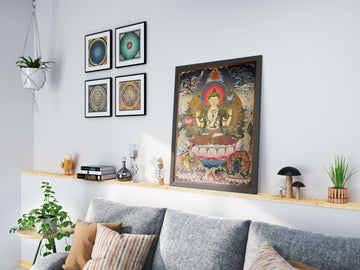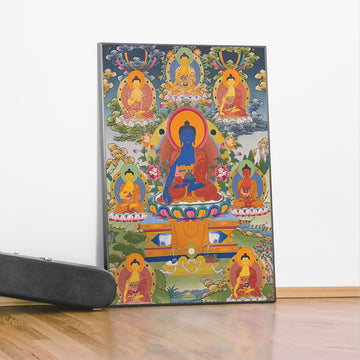Amitabha Buddha is a central figure in the Mahayana Buddhist tradition and is revered by many as a manifestation of the Buddha of Boundless Light. He is believed to have made a vow to save all beings from suffering and to bring them to his Western Paradise, also known as the Pure Land. According to tradition, Amitabha Buddha's Western Paradise is a realm of perfect peace and happiness, free from suffering and the cycle of death and rebirth. Those who recite Amitabha Buddha's name and sincerely desire to be reborn in his Western Paradise will be able to do so upon their death.
Thangka is a traditional Tibetan art form that involves painting or embroidering images of deities, buddhas, and other religious figures on fabric or parchment. Amitabha Buddha thangka is a popular subject in thangka art and is often used as a meditative aid for practitioners of the Tibetan Buddhist tradition. In Tibetan Buddhist art, each element and symbol has a specific meaning and significance. In an Amitabha Buddha thangka, the lotus throne that Amitabha Buddha sits on represents his enlightenment and the purification of his mind. The halo of light surrounding his head symbolizes his boundless wisdom and compassion. The gesture of granting boons with his right hand represents his vow to save all beings from suffering and bring them to his Western Paradise. The meditation mudra with his left hand signifies his attainment of ultimate peace and understanding.
Amitabha Buddha is often depicted in thangka art seated on a lotus throne, with a halo of light surrounding his head. His right hand is usually depicted in the gesture of granting boons, while his left hand rests on his lap in the meditation mudra. In some thangka paintings, Amitabha Buddha is also accompanied by two bodhisattvas, Avalokiteshvara and Mahasthamaprapta, who are believed to be his attendants in the Western Paradise. Avalokiteshvara, the bodhisattva of compassion, is depicted with a thousand arms and eleven heads, symbolizing his boundless ability to help all beings. Mahasthamaprapta, the bodhisattva of power, is depicted holding a vajra, which symbolizes his spiritual strength and ability to overcome obstacles.
Thangka art is an important part of Tibetan Buddhist culture and is used for both artistic expression and spiritual practice. Amitabha Buddha thangka is a popular subject in thangka art and is often displayed in temples and homes as a source of inspiration and guidance for practitioners. In addition to being used as a meditative aid, Amitabha Buddha thangka is also a popular choice for collectors of Tibetan and Buddhist art.
When creating an Amitabha Buddha thangka, Tibetan artists follow strict guidelines and techniques that have been passed down through the generations. The process begins with the preparation of the canvas, which is usually made from cotton or silk and treated with a mixture of glue and pigment to create a smooth surface. The artist then draws the outline of the image using a thin brush, before filling in the details with vibrant colors. The final step in the process is to apply gold leaf to the image, which is believed to symbolize the radiance and luminosity of Amitabha Buddha. Gold is seen as a symbol of purity and enlightenment in Tibetan Buddhism, and the use of gold leaf in an Amitabha Buddha thangka is meant to evoke the radiance and luminosity of the Buddha's teachings.
In conclusion, Amitabha Buddha thangka is a beautiful and meaningful art form that is deeply rooted in the Tibetan Buddhist tradition. It serves as a powerful reminder of the teachings of the Buddha and serves as a source of inspiration and guidance for practitioners on the path to enlightenment.





